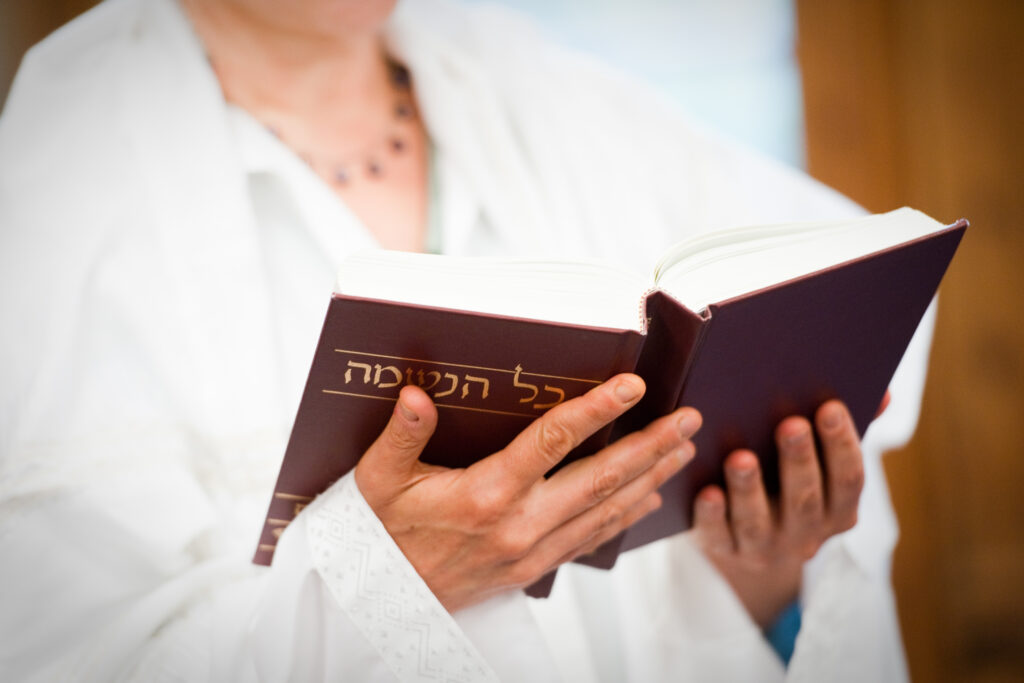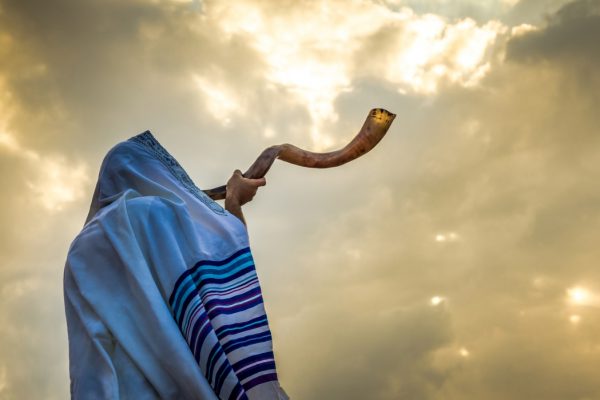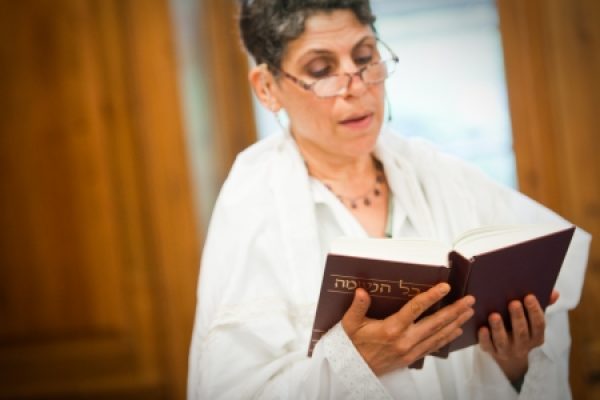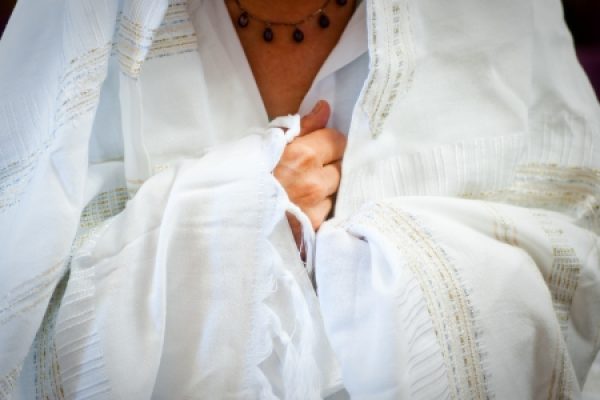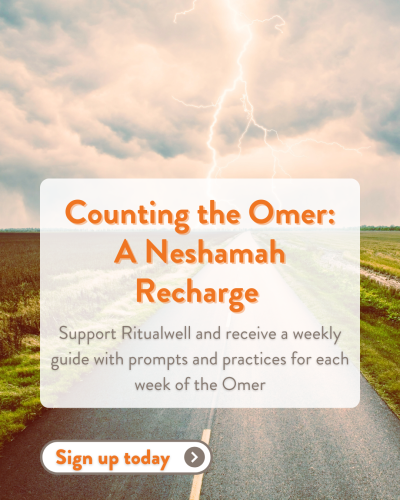An interpretation of the traditional Avodah (Amitz Koakh) read by four people on bimah.
A: In the beginning, God spoke with human beings, and human beings spoke with God.
B: Whatever God thought, that was in the heart of the human beings, and whatever the people felt, God understood. The people and their God were close, as they lived in the Garden of Eden that God had provided. The people kept God’s garden, and God watched over the people. God would call the people by name – and the people would call to God by name.
C: Yud—Hay—Vav—Hay.
D: The essential sounds.
A: The sound of the breath of life, breathed into the world each day by God.
B: “I was, am, will ever be.”
C: “I will be with you – do not be afraid.”
A: Then came the commandment, the fruit, and the trust was broken. Saddened, God no longer spoke to the people. And scared, the people no longer called God by name. The garden lay empty, and the people began their wanderings.
C: There was the flood, for the people multiplied violence all over the earth. Yearning for God’s presence, the people built a tower toward the heavens, but God sent it toppling down. And so it was, for generations and epochs. The people cut off from God, God cut off from humanity, and a deafening silence over an earth where no one spoke the true Name of God.
D: After centuries of stillness, God’s voice was again heard, first by Avraham and Sarah, then by Rivkah and Yitzchak, and then by Yaakov and Rachel and Leah. They spread the voice, telling of it to their families, and they became a great nation. But the Name itself remained a secret, God’s secret.
A: When the Children of Yisrael were taken into slavery, God followed them, and when they cried out, God rescued them. God chose from among them a leader, someone to speak to, as God had done in the earliest days. God brought Moshe to the mountain, and revealed the Name: Yud—Hay—Vav—Hay. “I will be with you in your suffering. I will be with you, whatever happens; I will be with you, do not be afraid.”
C: God brought all the Children of Yisrael to God’s mountain, Sinai, the place where God had spoken to Moshe from the burning bush. How God had rejoiced when Moshe listened, understood, asked to hear the Name again! How many generations, centuries, millennia, had God waited to say, “I will be with you”! And so, on the same site, God’s voice and teaching, God’s word, were made known to an entire people for the first time.
D: It is said that every Israelite heard God’s voice in the manner appropriate to him or her. It was all-filling, and utterly inspiring. And it brought God and the Children of Yisrael together as close as God and the first people had been long before in the Garden of Eden.
B: But when it ended, there was a void where the voice had been. The people were indeed afraid, and built their golden calf – and God again stood away, brokenhearted.
A: They reached an accommodation, the Children of Yisrael and God. They would collaborate on a Holy Place where God could be heard, but not as before. And God’s name would not again be spoken, not until that great day of redemption in the distant future. When the wound would be healed, when trust would be reestablished. When whatever God thought, that would be in the heart of human beings, and whatever the people felt, God would understand.
D: Until that day, the name of God would not be spoken by humanity except once each year, in the Most Holy Place, the Kodesh Ha-kodashim in Jerusalem. On Yom Kippur, the anniversary of the day God forgave the people for calling the Golden Calf their god.
C: Seven days before Yom Kippur each year, the Kohen Gadol would begin his preparations. He was accompanied by rabbis, who reminded him of the laws of the holy day and who told him stories about the days at the Mountain of God.
B: Rabbi,
A: asked the Kohen,
B: Is it true that every Jew who ever lived was standing there at Mount Sinai?
C: My friend,
D: replied the rabbi,
C: The soul of every Jew from every generation was there at Mount Sinai. Why else do all Jews everywhere seem to be familiar to one another? We were all there – you and I, and our parents before us, and their parents too. We all heard together.
B: When Moshe went up the mountain to receive the tablets of the covenant, what did he see?
C: We have learned that Moshe spoke with God face to face, as a person might speak with a neighbor. When Moshe was up on the mountain, he was surrounded by a cloud, and all he could see was a great light.
A: The Kohen was silent for a moment.
B: Rabbi, I have never before walked into the Kodesh Ha-kodashim. My father – may his memory be for a blessing! – my father was fortunate to carry out the service for Yom Kippur eighteen times. But he never told me what he saw there, inside the Most Holy Place.
D: Now the rabbi was silent. Slowly he began.
C: I have spent my life studying the Torah, looking into God’s words, straining to hear and to understand. But there is one thing I shall never be able to do, and that is what you will do on this holy day. You will stand there in the Holy Place, and you will be surrounded by the cloud just like Moshe, and see the dazzling light of the Shekhinah.
D: On the morning of Yom Kippur, the Kohen Gadol put on his special garments, the adornments handed down by the sons of Aharon. Near the altar, he stood over a bull, whose sacrifice would make him pure enough to enter the Most Holy Place.
A: And he made confession over the bull, for his own errors and for those of his family, and in his confession he spoke the divine Name for the first of three times. The people in the outer courts of the Temple fell on their faces in reverence. But the Kohen Gadol knew:
B: No, this is not it. I have made the sounds, but I have not spoken the Name.
C: The Kohen proceeded to two goats. By a miracle, they were absolutely identical: in age, in form, in stature. The Kohen drew a lot, and pronounced over one of the goats,
B: “A sin-offering for the Lord!”
C: There is a legend that once when the lot was cast, the other goat approached the Kohen Gadol.
D: Why does my twin brother merit that his blood should serve the Master of all Creation, why I must carry the sins of the Jews off into the wilderness and die for them? Take me instead, for I, too, am without blemish and wish to serve my Creator.
C: You too serve our Master, replied the Kohen. By taking these sins far away, you make it possible for the Shekhinah to dwell with us in this Holy Place for a single moment. Do not worry – you too are serving your Creator.
A: A scarlet thread was tied around the head of the scapegoat, and it was taken aside. The Kohen came to its brother, and made confession for the entire clan of Kohanim. For a second time, in his confession the Kohen spoke the divine Name. Again the people in the outer courts fell upon their faces in reverence. But again the Kohen Gadol knew:
B: No, this is not it. I have made the sounds, but I have not spoken the Name.
C: Now it was time to enter the Kodesh Ha-kodashim.
D: He took the firepan, full of hot coals. He put incense on it. In his other hand, the Kohen held the blood of the bull over which he had confessed his own sins. Quickly, the Kohen entered the Kodesh Ha-kodashim.
A: As he crossed from the Holy Place to the Most Holy Place, all of a sudden the incense lit up, and a cloud of smoke filled the Kodesh Ha-kodashim. The Kohen sprinkled the blood of the bull into the cloud.
C: He was enveloped in the cloud. He could see nothing, hear nothing.
A: He went out again and returned with the blood of the first goat, which he sprinkled again into the cloud. The cloud became thicker.
D: The Kohen Gadol was wrapped in the cloud as in a tallit. He could see everything, and hear everything.
C: The cherubs that stood atop the Ark of the Covenant in Solomon’s first Temple, embracing.
D: The stone called Eh-ven Sh’tee-yah, the first place God created on earth, at spot where he was standing.
A: Yud
D: The voices and faces of every Jew who had ever lived or would ever live.
C: The letters of the Torah, dancing in the air.
A: Hay
C: The Garden of Eden, where God and human beings had spoken so intimately.
D: The ram, whose horns would herald God’s Torah and God’s redemption.
A: Vav
D: The Yerushalayim Shel Ma’alah, the Heavenly Jerusalem, where all the world would one day flow to learn justice and to declare, “The Lord is One! Adonai Ekhad!”
A: Hay
D: The two original tablets of the Covenant, miraculously repaired.
C: The shining light of the Shekhinah.
A: And in a whisper, the Kohen believed he heard something:
B: I am with you – do not be afraid.
D: When the Kohen emerged from the Most Holy Place, his face was glowing.
A: He came to the scapegoat, and made confession for the wrongs of all the people of Yisrael.
B: Hashem—
A: —he began, respectfully addressing God as only “The Name”—
B: We have made mistakes, we have done wrong deliberately, we have neglected our obligations before you, we the whole House of Yisrael! Cleanse us for all our wrongs, as it is written in the Torah of Moshe, who recorded the words You spoke in Your own voice: “For on this day there will be Kippur for you, to cleanse you from all your wrongs before—
(slowly) Yud—Hay—Vav—Hay
A: The Kohen Gadol was speaking in his normal voice as he uttered the Name. Yet the sounds of the letters of the Name left his lips like thunder. It is said that even miles away, over the mountains, in Jericho, the voice of Kohen was heard.
D: At that moment, no bird sang, no lion roared, no other sound was heard from one end of the world to the other. Even the angels in heaven stopped singing “Kadosh kadosh kadosh,” their never-ceasing chant.
C: And the people, as they heard the Name pronounced so thunderously, heard something else, in a still small voice:
B: I was, am, ever will be. I am with You – do not be afraid.
D: They fell on their faces and proclaimed:
C and D: Barukh shem kvod malkhuto le’olam va’ed.
A: This time the Kohen knew he had made the sounds, and he had spoken the Name.
B: “You shall be cleansed!”
A: The Kohen finished the verse, and the ceremony was then completed. The scapegoat was led into the wilderness, and as it fell down the most distant cliff, the scarlet thread around its head turned white. Another identical thread had been tied to a post in the Temple, and at the exact moment it too turned white.
D: The Kohen Gadol read from the Torah, the same sections we have read today.
B: More than what we have read today is written here!
D: —he said when he had finished.
C: His eyes met the rabbi’s.
A: And the Kohen Gadol pronounced the ancient blessing of his family:
B: Yevarekhekha Adonai Ve’yishmerekha. Ya’ayr Adonai Panav Aylekha Vikhuneka. Yisa Adonai Panav Aylekha Ve’yasem Lekha Shalom. May God bless you and watch over you. May God’s face shine on you with grace. May God pay attention to you and bring you peace.
A: (brief pause) Such is the story of the service of the Kohen Gadol, which he would perform in the Temple every year on Yom Kippur before the assembled congregation of Yisrael. May it be Your will, O God, that one day soon You will be one with us as in the beginning, and that Your true Name will be known everywhere in the world.

